- 150 -
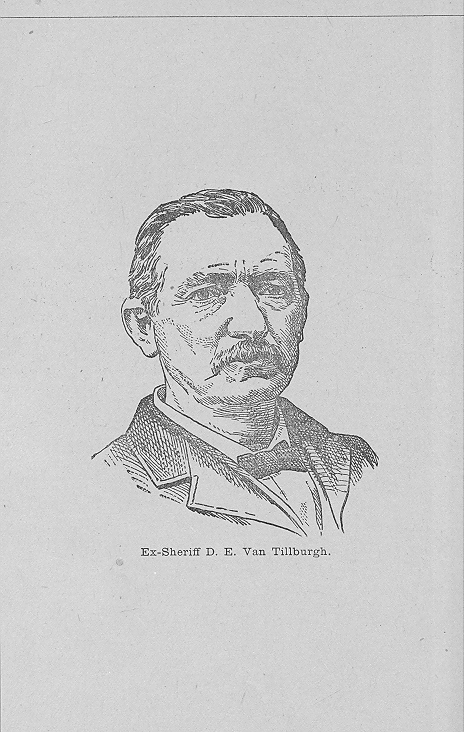
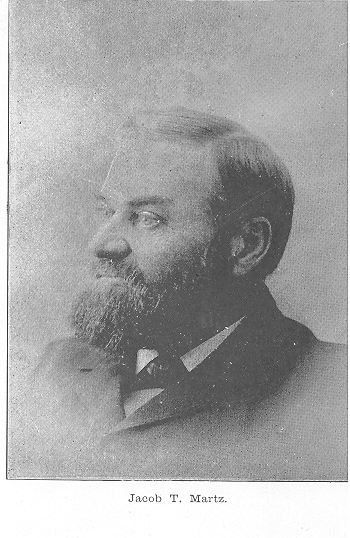
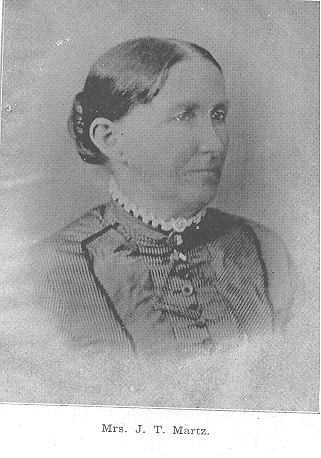
enrollment in the school for the year was 1098, showing that ninety-one per cent. of the entire enumeration was enrolled upon our school registers, while in efficiency the school stood second to none in the state. Under his supervision he saw the school grow from four to twenty-two teachers. When he took charge of the school there was no laboratory, no apparatus, no geological cabinet, except a few ordinary specimens ; but in June, 1888, over six hundred dollars had been expended for educational and philosophical apparatus of various kinds, and there was a large and convenient laboratory arranged with all the modern conveniences : geographical maps and globes, and physiological charts, enabling the teacher to illustrate and explain all the modern methods of teaching, together with a human skeleton procured, prepared and mounted by Mr. Martz and the janitor of the old school building and which they have kindly permitted to remain in the laboratory for the benefit of the students in physiology and hygiene. The cabinet containing various specimens of value (including the bones of the mastodon found in this county, arid which are in a remarkable state of preservation,) are the result of Mr. Martz's personal purchase and labor. During all these years, modern methods of teaching and government were introduced by the superintendent and adopted by the teachers, so that tardiness was measurably controlled by the teacher, and truancy, except in a few chronic cases, was almost a thing of the past. Order, system and good government prevailed in all the rooms and in the dismissal of pupils, while improper language was seldom heard on the play-grounds, and so potent was the influence of the superindent in maintaining order and decorum among the pupils on the play-ground, that it became the pride of all, even the most combative element among the boys, the moment they reached the school-grounds to stand upon their good behavior. The High-school course of study contained no more branches than could be mastered by every pupil of ordinary intelligence in the five years given to complete the same, while the elocutionary drill and composition writing, in all the grades in which they were taught, strengthened the memory and exercised the reasoning faculties to the great benefit of the pupils. No partiality was shown in these exercises as all were expected to do their part.
The method of graduation from the High school was Mr. Martz's suggestion and it has been adopted by at least four Union schools in this county, and the one .hundred and four Alumni all graduated under his supervision, which speak of the
- 151 -
good order, management and efficiency of the school. Superintendent Martz with two other teachers organized the Darke county teacher's association in 1859, and though for several years it struggled for existence, yet by his untiring energy and enthusiasm for its success it increased in numbers and interest almost beyond expectation. During the greater part of this time he presided over its deliberations. He was also a member of the Board of County-school Examiners for about twenty-two years, and assisted greatly in advancing the qualifications of the teachers in the county. He has also taken an active part in developing the resources of the county, and was for six years secretary of the Darke County Agricultural society, and was mainly instrumental in selling the old grounds of the society and purchasing the large and commodious grounds it now owns. For eight years he was secretary of the first Building-association organized in this county, having closed out the same ; and he has been for more than eight years secretary of the largest company of the kind now doing business in the county. Mr. Martz has always manifested a deep interest in the moral and religious influences in the county ; has for a long time identified himself with the Methodist Episcopal church ; has been superintendent of the Sabbath-school for a number of years, and for more than eight years has been recording steward of its official board. For the past year he has been associated with his law partner of 1865 and the present mayor of the city of Greenville in the legal profession. He has also assisted in all the local enterprises that were intended to advance the public good ; has been associated with the trustees of the Greenville cemetery as their secretary since 1865, and assisted in bringing about that order and system which has resulted in beautifying, adorning and enlarging those grounds to meet the public wants. On September 19, 1860 he married Miss Esther M., daughter of James M. Jamison, of Delaware, Ohio, with issue of four sons : John H., born Nov. 8, 1861 ; Adelbert, born Sept. 28, 1868 ; James J., born. May 8, 1872 and Benjamin F., born Dec. 18, 1874. The last two are now attending the Greenville High school. John is married and Adelbert is assistant teller of the Greenville bank, Greenville, Ohio.
- 155 -
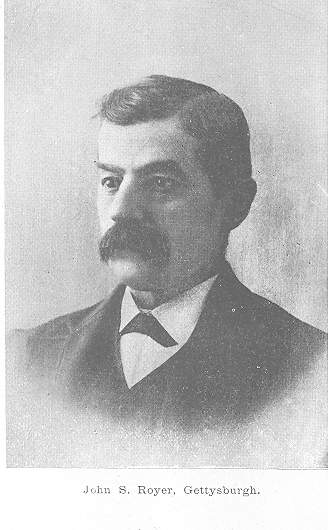
JOHN S. ROYER,
EX-COUNTY EXAMINER,
AS born in Union county, Pa., January 31, 1845, and spent his boyhood on a farm. He is of German and Swiss descent, and when he entered the common school he was not able to understand English. With wonderful aptitude, however, he soon acquired the language and took the lead in all his classes, attending but the one school in his home district, in his life, and but about fifty months in all. He commenced teaching at the age of fifteen. His first certificate was granted by Supt. D. Heckendorn, September 24, 1860. At the close of his first school he received the following unsolicited approval of his work : " This is to certify that John S. Royer has taught school No. 2, in Monroe township, Juniata county, Pa., during the session of 1860-61, to the entire approval of the Board of Directors and County Superintendent, and by industry and tact of training has been . very successful in advancing the pupils under his care." Signed by the superintendent and directors, April 27, 1861. After teaching four winters in Pennsylvania and working for his father on the farm, during the summer, he came to Ohio and took charge of the Pleasant Hill (then Newton) graded schools. The next year, by the solicitation of friends, he came to Darke county, where he has taught ever since with marked success. In this time he was seven years at the head of a graded school in Adams township, ten years at the head of educational affairs in Ansonia, and now .six years at Gettysburgh, where he has built up one of the best schools in the county, managing a Normal school in the summer vacation. It is said that he has prepared and sent out fully as many teachers as any other educator in the Darke county schools. His services as County-school Examiner for six years, commencing in 1879, brought about a great improvement among the teachers and in educational affairs generally. In 1880, by the urgent request and encouragement of that prince among mathematicians, Enoch B. Seitz, who was at the time a School Examiner also, Mr. Royer established the School Visitor, a magazine that has done a grand work in the profession. It is
- 56 -
pronounced by eminent educators to be the best magazine of its kind in America. He also founded the Ansonia Mirror, and reached in it the highest success in local journalism. He does his own press work on the School Visitor, and the difficult composition in mathematics and diagrams in grammar. He also engraves the fine wood cuts that illustrate the mathematical department of his magazine. He is eminently busy, and has a great power of endurance. For several years at Ansonia he was principal of schools, teaching the High-school department himself; editor and publisher of the Visitor and Mirror ; secretary of a Masdnic lodge ; leader of the Methodist Church choir, and an energetic. Sunday-school worker. He is truly a self-made scholar, and in all his teaching he aims to unite the practical with the ornamental in the development of a symmetrical culture. His liberal education was acquired by concentration of mind upon one subject until it was mastered. One summer, while spending the vacation at the old homestead in Pennsylvania, he mastered the study of trigonometry and surveying ; secured instruments and engaged for three years at his leisure in practical surveying. He has been twice married, and is blessed with a family of promising children, two girls and three boys : Minnie of the first, and Estella, Ray, Clyde and Edwin of the last marriage. Minnie was a useful assistant as compositor and clerk until her marriage to A. S. Hassinger, November 28, 1889, when she left for her new home in West Virginia. He has attained the highest honors in the Masonic, Odd Fellows and Good Templar lodges, and is a true Knight among the Pythians. We also find him superintendent of the Sunday-school, and an active member of the Presbyterian Church ; a member of the Executive committee of the Ohio Sunday-school Union, and a useful factor in the affairs 0f his community. He possesses rare qualities of mind and heart which have gained for him a large circle of friends. His many pupils speak with praise of the helpful and inspiring words and kindly favors they received from him as they passed through the labyrinths of abstruse, literary and scientific tasks.
- 159 -

LON C. WALKER,
COUNTY EXAMINER.
HIS boyhood schooling was obtained in a country school. He taught eight years in the country schools prior to his two years' course in the State University at Columbus and one year in Cornell University, whence he returned in 1888. Since then he has been one of the leading contributors of the School Visitor, Davenport Monthly, Mathematical Messenger and Mathematical Magazine. He has had some experience as superintendent. He has been a faithful reader of the Visitor from its infancy ; has spoken many good words in its behalf; has them bound and spends his leisure time very profitably in its perusal. The editor admires his style of solutions; has had the pleasure of corresponding with this scholarly gentleman, and is well acquainted with his literary productions, particularly contributions to the various mathematical periodicals. The Visitor family appreciate and are truly thankful for his interest taken in the mathematical department. He possesses very superior. mathematical talent. Having a special fondness for this branch of study, he devotes his leisure hours to the broad fields and hidden beauties of the higher mathematics, delving deep into the mine of original investigation, and astonishing his friends by the exactness with which he unfolds the beautiful and mysterious relations of numbers in the " bright seraphic truth." He possesses the qualifications of a mathematician of the highest order of excellence and brightest promise. His name will be' deservedly associated with those of Newton, Euler, Todhunter and others who have made the positive science a study. Hon. Probate Judge Anderson did a wise act in appointing Mr. Walker a member of the board of School Examiners August 15., 1889. He is doing much to improve the teaching in the common schools by his work as County Examiner. We can speak of our subject in no more appropriate terms than to publish the following letter addressed to the editor of this volume :
GETTYSBURGH, DARKE COUNTY, Dec. 18, 1889.
"George W. Wolfe, Greenville, Ohio.
"DEAR SIR.-I wish to state that Lon C. Walker of this county, is one of the most accomplished mathematicians in this country, and that his work is unique in pure and applied mathematics. A striking feature of his work is rigid accuracy and simplicity of demonstration. He is without doubt the most promising
- 160 -
and useful worker in the rich fields of this bewitching science. I can show you work executed by him in the mine of original investigation, that astonished the doctors of large experience and ripe scholarship.. Their commendations are strong and firm. I have a good opportunity to learn his superior ability, as I have about. twenty-five of the best mathematicians in the United States contributing to the School Visitor, of which I am editor, and which is devoted chiefly to the practical mathematics. You can speak in terms of highest praise of his untiring efforts in the wonderful development of his natural ability. He has been a close student and the light of his genius will gain for him a world-wide reputation.
" Yours truly,
" JOHN S. ROYER."
- 163 -
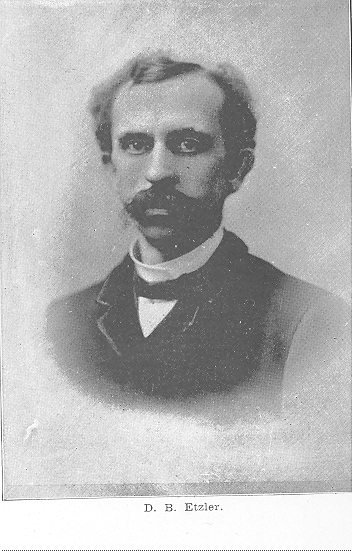
D. B. ETZLER,
COUNTY EXAMINER,
WAS born in Lewisburg, Preble county, O., July 30, 1848. At the age of four his parents removed one and one-half miles east of Lewisburg, settling on the farm where his mother still resides. At the age of eighteen he took charge of the farm and successfully Worked it for six years, when he began teaching school in his own neighborhood. His education was chiefly acquired in his home district school. Although deprived of the advantages of a college education he has taught for over sixteen years with marked success, both in the graded and ungraded schools of Darke and Preble counties. In February, 1885, he was appointed by Judge S. L. Kolp, to the position of County Examiner of Darke county. At the expiration of his term he received a re-appointment to the same position, which he now holds.
- 167 -
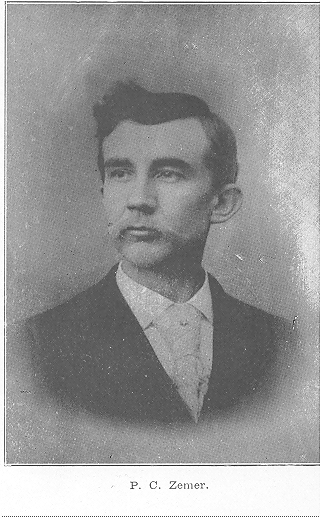
P. C. ZEMER,
COUNTY EXAMINER,
TRACES his ancestry back to Henry Zemer, of revolutionary times, who fought in the war for his country's independence. He came from Pennsylvania to Circleville at a very early period, and, with a large family, he moved from here to Houston, Shelby county, O., about 1820, locating upon a farm. His fourth child (George), was born near Circleville, O., in 1807. George
Zemer became acquainted with and married Elizabeth Day, daughter of Henry and Annie Elizabeth Day, who came from Loudon county, Va., at a very early period, to Belmont county, O.; thence to Houston, Shelby county, O., about 1822. Henry Day was also a farmer and fought in the revolutionary war. George and his wife located on a farm, near Houston, O., which they cleared and improved. To them five children were born ; the eldest, (Noah,) father of the subject of this sketch, was born in 1835. He united early with the Christian Church, of which he is yet an earnest worker. In 1856 he married Martha Ellen Cruse, a noble, intelligent, Christian woman, and daughter of Peter Cruse, a wealthy farmer. To this union were added three children : P. C. Zemer, John H. and Seth I. The mother died while the boys were quite young, but the influence of her Christian life will always be felt. P. C. Zemer was born on the farm near Houston, Shelby county, O., June 11, 1857. He attended the district school during a short period of the winter months. On January 22, 1878, through the influence of a friend, he went to the Normal University at Lebanon, O., where he remained three terms ; returning home he taught two winter terms of school and one summer term, after which he again returned to the Normal University at Lebanon, where he remained until he graduated from the College of Science, receiving the B. S. degree July 29, 1881. Returning home he married Miss Maggie F. Gartley, daughter of John Gartley, Ex-Commissioner of Shelby county and a prominent farmer. Mrs. Zemer was born on February 26, 1860. She is a Christian woman, broad in her views, clear in her judgment, and patient and cheerful in her home, which she loves. To this union there has been added four bright children : Stanley G., Beryl M., Ermie H. and H. Lowell. Little Ermie only remained a few months with her parents ; her little spirit was soon called back to
- 168 -
the Father who gave it. In the fall of 1881 Mr. Zemer took charge as Principal of the Lockington schools, Shelby county, O. His success was so decided that he was re-employed at advanced wages two months or more before his first school closed. He was offered the school again the third year, but refused it to accept the superintendency of the schools at Ansonia, Darke county, O., with advanced salary and greater responsibilities. His success here was as decided as at Lockington, as is shown by the fact that the day his schools closed, the first year, his School Board met and re-employed him at an advance of fifteen dollars per month. He is now serving his seventh year at Ansonia, and within these years his salary has been advanced three times for efficient work. The number of foreign pupils in the High school has been increasing until about one-third of the High school are pay pupils. These come from one to nine miles to prepare themselves for teaching-. He served on the Executive committee of the Darke County Teachers' Institute four years, the last year as chairman of the committee. By a general call from the teachers he was made President of the Darke County Teachers' association, August, 1889. Mr. Zemer is also President of the Darke County Board of School Examiners, having- been appointed a. member of that board February 22, 1889, for an unexpired term by Judge L. C. Anderson, at the request of many prominent teachers and other warm friends. He was re-appointed for three years, August 31, 1889, and is now serving in that capacity.
- 171 -
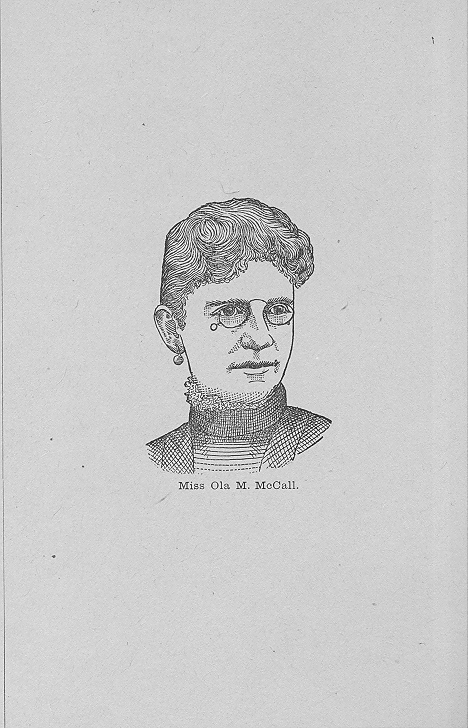
MISS OLA M. M'CALL,
MUSICAL INSTRUCTOR.
MISS M'CALL, the subject of this sketch is worthy of more mention than we can give in this brief biography. She was born in Galesburg, Ill., and while quite young her parents removed to Marshall, Mich. Her father's name is Oliver W., and her mother's maiden name was Catharine A. Compton. In 1875, they removed from Michigan to Keokuk, Ia., and for twelve years she pursued instruction in music, both piano and vocal, under the best tutorship that could be obtained. In 1887, she entered the Detroit Conservatory of Music and studied there for one year, afterward studied special voice culture with Prof. J. D. Mehan. She is a graduate of the National Music school of Chicago, a Normal institute where students are trained to teach the national system of school music. She goes to Boston, Mass., for special work in 1890. At present she is the instructor in music in the Greenville schools and is highly appreciated in her efforts. Miss
McCall is one of the very brightest young ladies in her profession in the state. One of those positive characters rarely found ; knows no defeat ; as thoroughly determined to reach the top round in the ladder of fame as though her life depended upon it. Her individuality leaves a lasting impression upon all who chance to meet her. Her labors in the Greenville schools have been crowned with success and have endeared her to the citizens who will be loth to part with her and her highly successful labors.
- 173 -
CITY OFFICIALS.
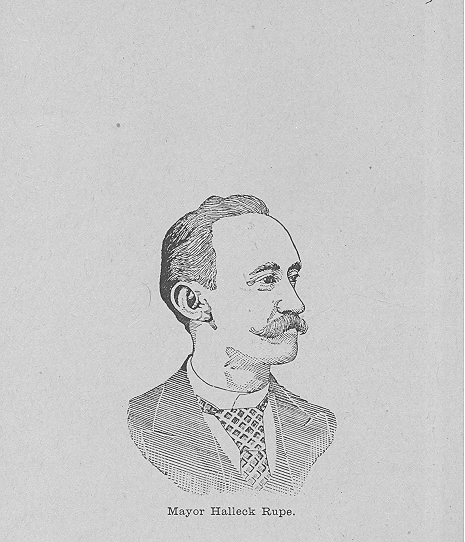
HALLECK RUPE,
MAYOR.
GERMAN township, Darke county, O., was the birth place of Mr. Rupe, and the date July 24, 1862. He was admitted to the bar and began the practice of law October 8, 1884, and was elected Mayor of the city of Greenville in April, 1889. Mr. Rupe is one of the brightest and most promising young men in this section of the country, as his election to the Mayoralty of Greenville on the Republican ticket with a large Democratic majority to overcome is evidenced. His rapid rise into political and professional prominence is well merited, and is of a substantial character. He is at present a member of the law firm of Knox, Martz & Rupe, which sustains a splendid reputation for legal ability throughout this section of the state.
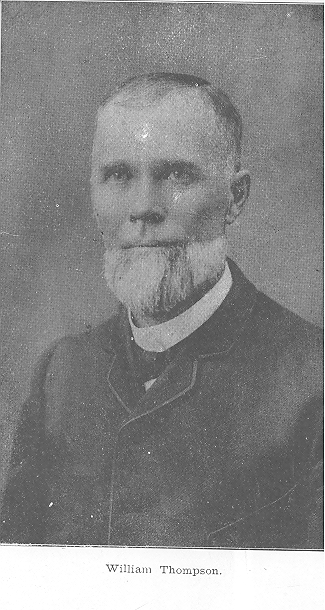
WILLIAM THOMPSON,
COUNCILMAN.
NOVEMBER 16, 1836, the subject of this sketch was born, upon a farm in Washington township, Darke county, Ohio. He received a common-school education ; followed farming until
1882, when he removed to Greenville and engaged in the livery business, owning the largest and best equipped establishment in the county. Mr. Thompson still owns and conducts a farm in Neave township, and is meanwhile engaged in the timber business, his specialty being to furnish cross ties for the Dayton and Union Railroad company. He was elected a member of the Greenville City Council in 1888, which office he still fills. He held the position of superintendent of the Darke County Infirmary for the years from 1866 to 1873. He chose for his companion through life, Miss Amanda Neal, of Neave township, this county, and have had two children: Alice and Venora.
- 179 -
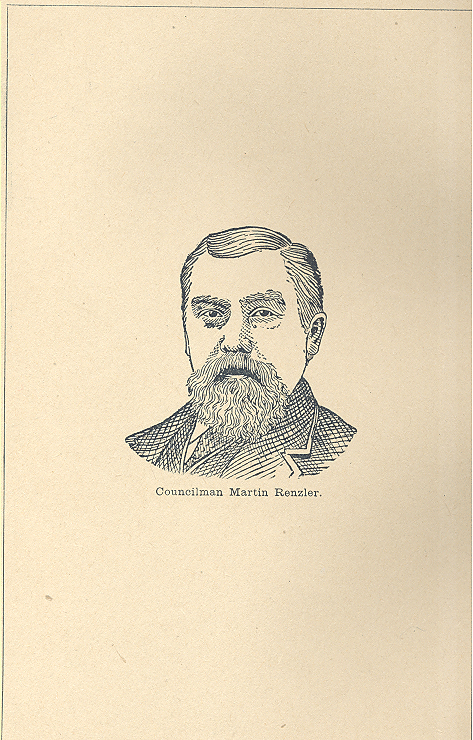
MARTIN RENZLER,
COUNCILMAN,
MEMBER of the Greenville City Council and general blacksmith, carriage and wagon builder, was born December 30, 1847, and located in Darke county in 1873. He was united in marriage to Miss Catharena Schmermand in 1874, and they have had born t0 them four children, viz.: Frederick, Carl, Catharena and Wilhelm. Mr. Renzler is one of the most highly respected citizens of Darke county, and his large carraige, wagon and blacksmithing business, located on East main street, is constantly growing, and gives evidence of the superior business ability of its proprietor.
- 181 -
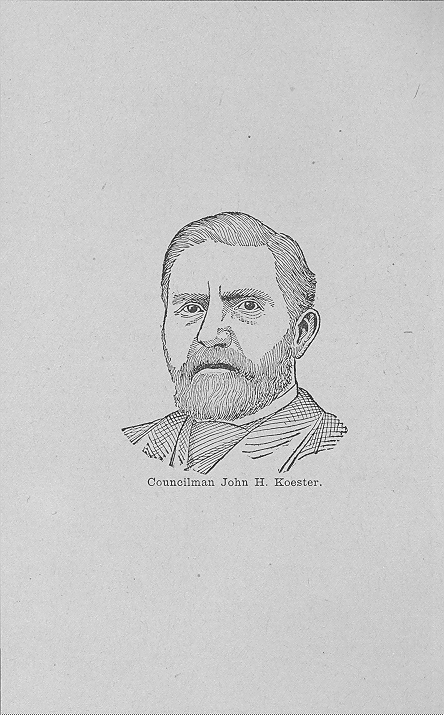
JOHN H. KOESTER,
COUNCILMAN,
MERCHANT tailor and member of the Greenville City Council, first saw the light of day in Germany, in 1840, and came to America in 1864, locating in Dayton, Ohio. He removed to Greenville, Ohio, in 1868, and was employed as cutter in a merchant-tailoring establishment until 1873 when he formed a partnership with John Compton, and they conducted the business under the firm name of Koester & Compton. His partner, Mr. Compton, died that same year and Mr. Koester became the sole proprietor and has conducted the business alone up to the present time. His high character and keen sense of justice in his business methods, coupled with pleasing manners, has made him one of the most successful business men in Darke county, and his friends and patrons are numbered by his acquaintances. Mr. Koester was married to Miss Elizabeth Kuntz, of Dayton, Ohio, but death dissolved the happy union April, 28, 1887, and his wife went to join the three children who had preceded her into the great beyond, while six children remain a solace to their father. Mr. Koester was elected to the City Council of Greenville in the spring of 1888, and is still a member of that body.
- 183 -
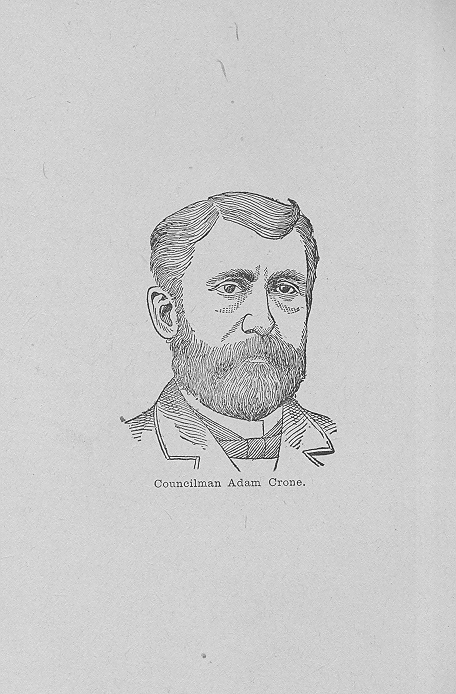
ADAM CRONE,
COUNCILMAN,
AT Cassella, Mercer county, O., the subject of this sketch was born November 1, 1851. His parents died while he was quite young. Being thus left an orphan he spent his early years at blacksmithing, serving an apprenticeship for two years in Celina, O., at this occupation. After obtaining complete mastery of his trade, and working in several cities throughout the state, he moved to Greenville in the autumn of 1874, where he has since resided. Having been elected as a member of the City Council in the spring of 1887, he discharged the duties of that office to the best interests of the people, who, seeing his honesty and fidelity, and comprehending the value of his services as a public officer, re-elected him in the spring of 1889.
- 185 -
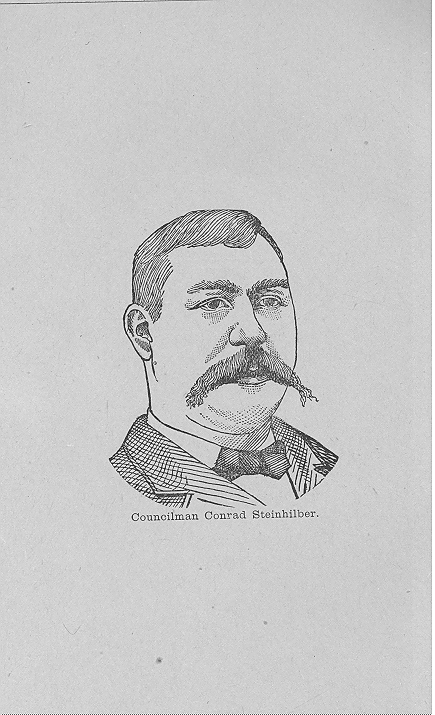
CONRAD STEINHILBER,
COUNCILMAN,
BORN in Cincinnati, O., November 8. 1859. Mr. Steinhilber is of German descent, and possesses those sturdy traits of character peculiar to that race. He received a common-school education in the Greenville Public schools, and entered the bakery and confectionery business, which he conducts on Broadway street in Greenville. He was married to Miss Dolly Stover, of German township, November 26, 1882, but their family circle has been broken by the death of their two children, Roscoe and Eva. Mr. Steinhilber took the initiatory step into politics by being elected to the City Council in 1887 from the First ward, which has a large Republican majority, and re-elected in 1889. He is the youngest member of that useful and usually much abused body, and in recognition of his superior ability as a presiding officer was elected President. It is needless for us to speak of Mr. Steinhilber's popularity in the city and county. Although at sterling Democrat,
he is not an " offensive partisan," and therefore has a large and influential following from his acquaintances, which is not confined to his own party.
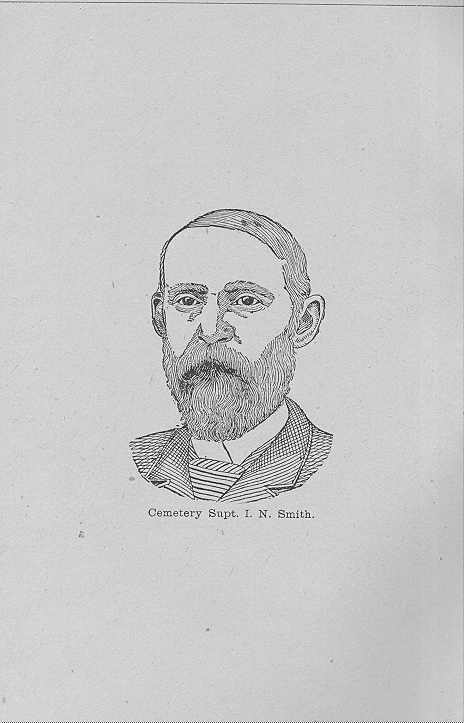

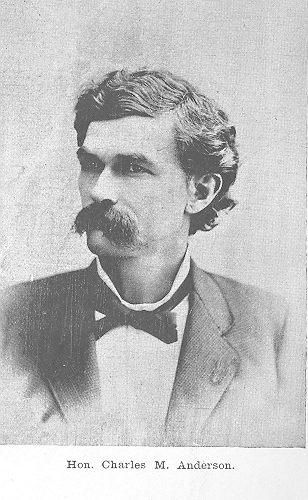
THE LEGAL PROFESSION.
CHARLES M. ANDERSON,
BORN in Juniata county, Pa., January 5, 1845, and came with his father's family to Ohio in April, 1855 ; was reared on a farm ; taught school ; served in an Ohio regiment during the war as a private soldier, and was honorably discharged the day he was twenty-one years old. He attended college for . a season at Lebanon, O., read law and was admitted to the bar in May, 1868, and at once entered upon the practice of his profession at Greenville, O. While always taking an active part in politics he refused all promotion in that line until 1878, when he made an effort to secure the nomination for Congress. The convention met at Sidney, O., and continued in constant session for three days and nights, and Anderson was defeated for the nomination by one and a quarter votes ; again, in August, 1884, he was a candidate for nomination for Congress in the Dayton district, which resulted in his nomination on the first ballot. In 1886, by reason of the redistricting of the state just before the convention which met at Celina, O., (the delegates in most of the districts having been selected and instructed before,) Anderson found his home county placed in the new district by the recent redistricting bill, and Hon. S. S. Yoder was nominated after the convention was on its second days' work. Mr. Anderson was made Judge Advocate General of Ohio in January, 1884, by Governor Hoadly, which position he held during Governor Hoadly's term of office. During this time the great riot in Cincinnati took place, and Mr. Anderson was, as such staff officer, on duty during most of that time, being second in command of the Ohio troops, and received the especial compliments of the Governor for his splendid services on that occasion, His practice at law is a lucrative one, and
- 192 -
he invests his income in erecting business blocks, having built more business houses than any other man up to the present date ; was the first to use pressed brick and plate glass. He is always found at the front in public enterprises, and doing his full share wherever the welfare of his home town or county is at stake. In Society lodges we find he took all the degrees in the I. O. R. M., K. of P., and all the degrees in Masonry, York and Scottish Rites, (excepting the 33d degree,) and takes an active part in the G. A. R.; is an officer and one of the largest stockholders in the Greenville Law Library. In 1887 he was appointed by the Speaker of the House of Representatives one of the Board of Visitors of the National Military academy at West Point. In June, 1870, he was married to Miss Ella Hart, the only daughter of Moses Hart, a builder and contractor, which marriage has been blessed with two boys ; the eldest, William H., is now on his second year at West Point as a cadet ; the youngest, Robert T., is still at home with his parents.
- 195 -
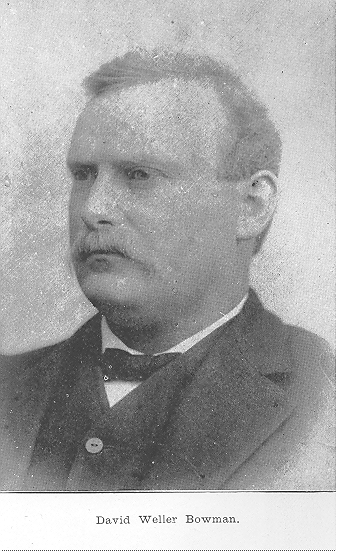
DAVID WELLER BOWMAN.
SECOND son of George W. and Phebe Jane Bowman, was born on a farm two miles east of New Madison, Darke county, O., on January 20, 1860. His father was a native of Franklin county, Pa., and removed to Darke county, O., with his parents in 1838. His grandfather on the maternal side, Michael Noggle, was of Pennsylvania stock, his ancestors being natives of Franklin county, in said state, and removed to Ohio early in the present century. His grandmother on the maternal side was of English ancestry, they being natives of Georgia and the Carolinas before removing to Ohio. The subject of our sketch was reared on his father's farm, and received his education in the common schools of his neighborhood and in the High school at Greenville, O. At the age of eighteen he began teaching school, and taught eighteen months before attaining his majority. On' April 4, 1881, he entered the law office of Allen, Riffel & Otwell, attorneys, Greenville, O., and began the study of law, and in October following entered the office of Hon. J. W. Sater, with whom he pursued his legal studies until May 1, 1883, on which date he was admitted to the bar by the Supreme Court at Columbus. He at once began the practice of law at Greenville, and on February 4, 1884, formed a partnership with the Hon. D. L. Meeker, which partnership continued until May 14, 1888, and was dissolved because of the election of Mr. Meeker to the office of Common Pleas Judge. On July 1, 1888, he entererd into a, partnership with Hon. C. M. Anderson, with whom he is still associated. On April 20, 1887, at Greenville, O., he was married
to Miss Belle Kerlin, daughter of William K. Kerlin, President of the Second National Bank. One daughter, Helen, has been born to them.
- 196 -
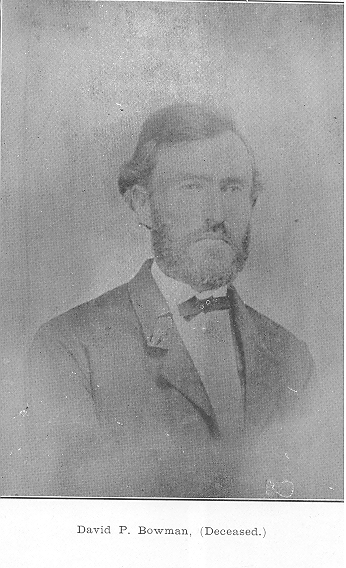
DAVID P. BOWMAN,
(DECEASED.)
THE subject of this sketch was born January 16, 1841, on a farm now owned by Thomas Finnarn, a few miles southeast of Palestine, in German township, Darke county, O. His parents, Abraham and Mary Bowman, removed from Franklin county, Pa., to Darke county, O., in the spring of 1838. His father was a native of Berks county, Pa. His ancestry was highly respectable. Jasper Bowman, of the paternal side, immigrated from Germany to eastern Pennsylvania, early in the Eighteenth century ; the maternal side was also of German extraction, Americanized about one hundred and fifty years, and although bearing the same name as the paternal, a searching investigation failed to show the slightest trace of relationship. D. W. Bowman, a sketch of whom appears in another part of this work, belongs to the same family ; his father being a brother of the said D. P. Bowman. The subject of this sketch passed his boyhood on a farm, and was inured to all the toil that fell to the lot of the farmer's son of that clay. He was without the advantages of an early education, having no opportunities therefor, and he was. fourteen years old before he could read. In the autumn of 1860 he began teaching school, and taught in the schools of his county without intermission until 1872. In 1861 he studied at Heidelberg college, Tiffin, O. The next three years were devoted to reading and study, and from 1865 to 1872 he pursued the avocation of a farmer. In March, 1872, he removed to Greenville, O., and having previously studied the law for several years, he was called to the bar by the District Court of Logan county, O., sitting at Bellefontaine, August 29, 1872. He immediately began the practice of law at Greenville, and continued in practice until his death, which occurred after a short illness, May 30, 1878. He was married to Miss, Mary E. Ream, a very estimable lady, on November 20, 1864. Six children were born of this marriage, only two of whom with their mother survive. His eldest son, Willis, a youth of great promise, died a few days before his father, which event contributed largely to the latter's death. Although his career at the bar was short, yet it was full of promise. He possessed qualifications that would have placed him in the front rank. He was entirely devoted to his chosen profession. His knowledge of the law was both accurate and profound. His
- 199 -
preparation was thorough. He came into the forum "not decorated for pomp, but armed for battle." In the power of analysis and logical reasoning, in clearness of statement and keen discrimination, in the ability to discern the vital points, and in the vigorous presentation of principles, he excelled. In industry, integrity, professional honor, fidelity to his clients and respect for the Court, he stood as on example to the bar. At the time of his death he was the law partner of Gen. C. M. Anderson. Outside of the law he was a hard student. He believed with Mathew Hale Carpenter, that his legal education would be incomplete unless he was familiar with all those works which belong to the border-land between literature and the law ; with philosophers and poets ; theology ; romance, and history. His reading, therefore, was varied and extensive. His favorite author was Macaulay ; having, also, a strong attachment for the ancient classics. An accomplished German scholar, he was familiar with the literature of that land. He possessed poetic talent, and wrote verses of no small merit. He was truthful, honest, sincere, earnest, magnanimous and brave. He was gentle and sociable, and a general favorite in society's circles. He was a Democrat in politics, and a patriot in the hour of his Nation's peril. He had a deep sense of religious duty. As Daniel Webster said of Jeremiah Mason : " He could not look on this mighty system—
'This universal frame, thus wondrous fair,'
without feeling that it was created and upheld by an Intelligence to whom all other intelligences must be responsible." He believed in the Bible, and in the efficacy of the Atonement made on Mount Calvary. In this faith died all his household for generations before him wherever they inherited family and name. And in that faith, with an unfaltering trust, "All the days of his appointed time did he wait until his change came." He .was buried away in that beautiful " City of Silence," the old church-yard at New Madison, Ohio.